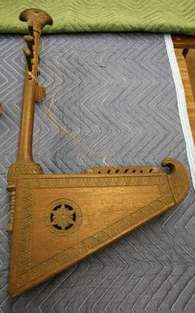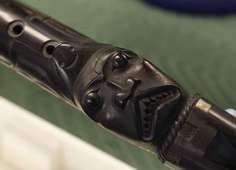As I’ve said before, you never know what you’ll find in the basement — even if you work at an art museum. Here’s another case in point.
 Over the weekend, the Cincinnati Enquirer ran an exclusive about a find at the Cincinnati Art Museum: more than 800 antique musical instruments have “languished” in storage for decades, forgotten and untouched. Charles Rudig, a former head of musical instruments for Sotheby’s, said about the discovery:
Over the weekend, the Cincinnati Enquirer ran an exclusive about a find at the Cincinnati Art Museum: more than 800 antique musical instruments have “languished” in storage for decades, forgotten and untouched. Charles Rudig, a former head of musical instruments for Sotheby’s, said about the discovery:
They’ve got a fabulous world music collection. It’s wonderful. It’s big. And it’s very similar to the Metropolitan Museum (New York) collection. The Met’s is bigger, but they were both formed at about the same time – the late 19th century.
Rudig has been hired as a consultant to assess and catalogue the collection, which the newspaper said “spans four centuries and represents the cultures of more than 20 countries on four continents.”
Among the treasures are a “19th-century African drum carved from a log, a Burmese crocodile zither, a Chinese version of a hammered dulcimer, a Native American ceremonial raven rattle and a beautifully carved Turkish harp… a rare 17th-century Amati viola, an 18th-century oboe d’amore by Jakob Denner (one of four known to exist) and a stunning Ruckers virginal (a keyboard instrument), one of just two known in the country.”
The museum plans to clean 75 to 100 of the instruments and display them in 2012, when the World Choir Games take place in Cincinnati.
Here’s a link to the article.
But then, the article says, while some pieces with be interspersed in the galleries, the museum has no plans to create a gallery for them. The director, Aaron Betsky, says that wouldn’t fit the museum’s current mission.
 I’m not sure why not. I could not find the museum’s mission statement on line, but in the volunteers’ section, it was stated simply as “to bring people and art together.”
I’m not sure why not. I could not find the museum’s mission statement on line, but in the volunteers’ section, it was stated simply as “to bring people and art together.”
On Guidestar, the CAM states its mission this way:
We will actively engage a diverse and growing audience with great art for the enrichment and enjoyment. We will collect, preserve, study and exhibit art in accordance with the highest professional standards. We will operate in a fiscally responsible manner.
In the Enquirer article, Betsky himself is quoted as saying, “When I arrived here in 2006, a few of them were out, like the Amati in the case upstairs … I found out that we hadn’t really paid attention to this incredible collection because, like so many other parts of our collection, we don’t really have enough room. This is really about instruments from around the world. And it was collected for the visual intensity of the pieces, not necessarily for their functionality. It shows the delight that people took in designing and decorating these objects.”
Giving them permanent space doesn’t seem off-mission to me. Of course, I don’t know what else is in storage, so I can’t make the call.
But I’m not the only one who seems to feel this way. Quoting the article:
J. Kenneth Moore, curator in charge of the Musical Instruments Department at the Metropolitan Museum of Art in New York. “You don’t find these things in many places. You just find them in a handful of places. It’s something that, I think, should be put on display and should be appreciated by Cincinnatians, and people who visit your city. It should be a point of pride.”…
“We have seen an increase of visitors in our [musical instrument] galleries, and it’s not only just the treasures of Western art music,” the Met’s Moore said. “I think there is more of an interest in the non-European cultures, in understanding them on various levels, and music is one of them. Certainly, the instruments can tell you a lot about what’s going on.”
It seems to me that displaying these instruments would be one way to distinguish and differentiate the Cincinnati Art Museum, in an era when many museum collections seem generic.
Photo Credits: 19th C. Balkan angel harp (top); 19th C. Native American carved flute, detail (bottom), Courtesy of the Cincinnati Enquirer
